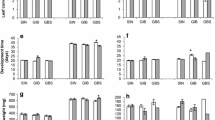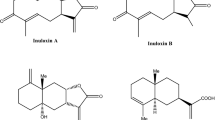Summary
The chemical stimulation of oviposition byPieris rapae on cabbage was investigated by leaf washing and extraction. Isolation of the stimulant by various chromatographic techniques was monitored by a bioassay using Sieva bean as a surrogate host plant. Cold water, chloroform, or chloroform followed by cold water washes failed to release the stimulant from leaf surfaces. Boiling water or chloroform followed by methanol was required. The most active stimulatory compound was identified as 3-indolylmethyl glucosinolate (glucobrassicin). Other glucosinolates were identified as sinigrin, which was only slightly active, and glucoiberin, which was completely inactive as a stimulant. The significance of the selective response ofP. rapae andP. brassicae to different glucosinolates and the implications of the binding of polar allelochemicals to leaf surfaces is discussed with respect to host utilization and perception mechanisms of pierids.
Similar content being viewed by others
References
Boodley JW, Sheldrake R (1977) Cornell peat-lite mixes for commercial plant growing. Cornell Info Bull 42:1–8
Chapman R, Bernays E (1989) Insect behavior at the leaf surface and learning aspects of host plant selection. Experienta 45(3):215–222
Chew FS (1988) Searching for defensive chemistry in the Cruciferae, or, do glucosinolates always control interactions of Cruciferae with their potential herbivores and symbionts? No! Pp 81–112in Spencer KC (ed) Chemical Mediation of Coevolution. New York: Plenum Press
Daxenbichler ME, Spencer GF, Carlson DG, Rose GB, Brinkler AM, Powell RG (1991) Glucosinolate composition of seeds from 297 species of wild plants. Phytochemistry 30:2623–2638
Feeny P, Sachdev K, Rosenberry L, Carter M (1988) Luteolin 7-0-(6′′-0-Malonyl)-β-D-Glucoside and trans-chlorogenic acid: Oviposition stimulants for the black swallowtail butterfly. Phytochemistry 27:3439–3448
Hovanitz W, Chang VCS (1963) Comparison of two mustard oils and their glucosides toPieris larvae. Lepidoptera 2:281–288
Ma WC, Schoonhoven LM (1973) Tarsal contact chemosensory hairs of the large white butterfly,Pieris brassicae and their possible role in oviposition behaviour. Entomol exp appl 16:343–357
Minchinton I, Sang J, Burke D, Truscott RJW (1982) Separation of desulphoglucosinolates by reversed-phase high performance liquid chromatography. J Chromatogr 247:141–148
Nielsen JK (1978) Host plant discrimination within the Cruciferae: feeding responses of four leaf beetles (Coleoptera: Chrysomelidae) to glucosinolates, cucurbitacins and cardenolides. Entomol exp appl 24:41–54
Nishida R, Fukami H (1989) Oviposition stimulants of an Aristolochiaceae-feeding swallowtail butterfly,Atrophaneura alcinous. J Chem Ecol 15:2565–2575
Ohsugi T, Nishida R, Fukami H (1991) Multi-component system of oviposition stimulants for a Rutaceae-feeding swallowtail butterfly,Papilio xuthus (Lepidoptera: Papilionidae). Appl Ent Zool 26:29–40
Peterka S, Fenwick GR (1988) The use of flash chromatography for the isolation and purification of glucosinolates (mustard oil glycosides). Fat Sci Technol 90:61–64
Reed DW, Pivnick KA, Underhill EW (1989) Identification of chemical oviposition stimulants for the diamondback moth,Plutella xylostella, present in three species ofBrassicaceae. Entomol exp appl 53:227–286
Renwick JAA (1989) Chemical ecology of oviposition in phytophagous insects. Experienta 45:223–228
Renwick JAA, Radke CD (1983) Chemical recognition of host plants for oviposition by the cabbage butterfly,Piers rapae (Lepidoptera: Pieridae). Environ Entomol 12:446–450
Renwick JAA, Radke CD (1985) Constituents of host and nonhost plants deterring oviposition by the cabbage butterfly,Piers rapae. Entomol exp appl 39:21–26
Renwick JAA, Radke CD (1988) Sensory cues in host selection for oviposition by the cabbage butterfly,Pieris rapae. J Insect Physiol 34:251–257
Rodman JE, Chew FS (1980) Phytochemical correlates of herbivory in a community of native and naturalizedCruciferae. Biochem System Ecol 8:43–50
Rothschild M, Alborn H, Stenhagen G, Schoonhoven LM (1988) A strophanthidin glycoside in Siberian wallflower: a contact deterrent for the large white butterfly. Phytochemistry 27:101–108
Sachdev-Gupta K, Renwick JAA, Radke CD (1990) Isolation and identification of oviposition deterrents to the cabbage butterfly,Pieris rapae, fromErysimum cheiranthoides. J Chem Ecol 16:1059–1067
Schoonhoven LM (1972) Secondary plant substances and insects. Recent Adv Phytochem 5:197–224
Schoonhoven LM (1990) Host marking pheromones in Lepidoptera, with special reference to twoPieris spp. J Chem Ecol 16:3043–3052
Schoonhoven LM, Beerling EAM, Klijnstra JW, van Vugt Y (1990) Two related butterfly species avoid oviposition near each other's eggs. Experientia 46:526–528
Städler E (1986) Oviposition and feeding stimuli in leaf surface waxes. Pp 105–121in Juniper B, Southwood R (eds) Insects and the Plant Surface. London: Edward Arnold
Städler E (1992) Behavioral responses of insects to plant secondary compounds. In pressin Berenbaum MR, Rosenthal GA (eds) Herbivores: Their Interaction with Secondary Plant Metabolites. New York: Academic Press
Städler E, Roessingh P (1990) Perception of surface chemicals by feeding and ovipositing insects. Pp 71–86in Szentesi A, Jermy T (eds) Proc 7th Int Symp Insect-Plant Relationships. Symp Biol Hung 39
Tiedink HGM, Malingré CE, van Broekhoven LW, Jongen WMF, Lewis J, Fenwick GR (1991) Role of glucosinolates in the formation of Nnitroso compounds. J Agric Food Chem 39:922–926
Traynier RMM (1986) Visual learning in assays of sinigrin solution as an oviposition releaser for the cabbage butterfly,Pieris rapae. Entomol exp appl 40:25–33
Traynier RMM, Truscott RJW (1991) Potent natural egg-laying stimulant for cabbage butterflyPieris rapae. J Chem Ecol 17:1371–1380
van Loon JJA, Blaakemeer A, Griepink FC, van Beek TA, Schoonhoven LM, de Groot A (1992) Leaf surface compound fromBrassica oleracea (Cruciferae) induces oviposition byPieris brassicae (Lepidoptera: Pieridae). Chemoecology 3:39–44
Verschaffelt E (1910) The cause determining the selection of food in some herbivorous insects. Proc Acad Sci Amsterdam 13:536–542
Author information
Authors and Affiliations
Rights and permissions
About this article
Cite this article
Renwick, J.A.A., Radke, C.D., Sachdev-Gupta, K. et al. Leaf surface chemicals stimulating oviposition byPieris rapae (Lepidoptera: Pieridae) on cabbage. Chemoecology 3, 33–38 (1992). https://doi.org/10.1007/BF01261454
Received:
Accepted:
Issue Date:
DOI: https://doi.org/10.1007/BF01261454




